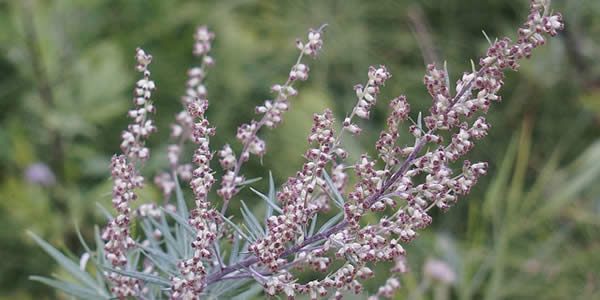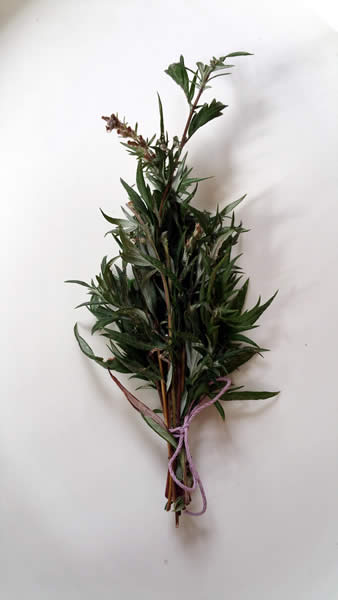Once called the ‘King of the Herbs’ by ancient Druids, there are few plants as well known for an ability to impart prophetic dreams than Mugwort. Here in the garden are two kinds, Artemesia douglasiana, a Western North American native, and Artemesia vulgaris, its European cousin that the Druids knew.

Artemesia vulgaris is an interesting name. In Latin it describes the Goddess of Wisdom, Artemis. Then, “vulgaris” means common, or of the people. Then this is, by name, a plant of common wisdom. In the plant kingdom there are other Artemesias, but this is the one for everyday people.
Last night a friend stopped over on her travels and in the course of conversation, she asked to visit the European Mugwort; it is a coveted specimen in the herb garden that claims an equally coveted sunny space at the lowest entrance of the terraced hillside. Like a guardian at the gates of the underworld, here mugwort waits to delve into dreams with you.

Mugwort likes a lot of room, as most perennial herbs do if given a place for the roots to ramble deep in soil. Yes, with care one may grow these herbs in pots. And although this may be perfect for the urban balcony hedge witch, it is a commitment, too. Herbs will require constant water and tending in this circumstance. Regular feeding with aged compost, and frequent trimming, too.
Around here, our herbs have lots of toe-room. Therefore, the maintenance required is almost nothing. Feed the soil with organic mulch: two inches, twice a year; monthly water in the dry season; and an annual harvest once the seeds are set and the plant gets leggy.
Pruning is a necessary evil in the garden or mugwort, like sage, mint, bee balm, nasturtium, and even rosemary, will take over a plot of sunshine in a few seasons, thriving on your benign neglect.
You see, when the plant gets leggy, it wants to travel. It will grow its branches long and push all the leaves to the end of each stem. The long branches lay seemingly helpless on the ground. But this is all part of the plan for roots to grow into the earth from the stem where it lays touching the soil.
By trimming the plant back to its original size annually, it can be maintained within a three foot by three foot space (approximately one square meter). Because I am saving the plant trimming for magickal purposes my process for harvesting herbs also has its peculiarities.
First, use bedside manners (planting bed-side, that is) and ask permission of the plant. After all it is giving up rather a lot in the deal. Remember that “please” and “thank you” are the first magic words we learn. They are still magic.
Tell the plant what you are doing and ask if it is willing to help. Stay open as you await a response. Usually I receive an excited “Yes!” or a sleepy “Hmmm? alright…” and sometimes, in the quiet waiting an herb will tell me more. Listen to “NO!” There may be a very important reason for it.
Secondly, the harvested plant matter should not touch the ground. This is very important and is an instance where magickal practice and practical magic are the same for two very different reasons.
In practical terms, harvest that touches the ground is infinitely more germ and fungus contaminated than leaves that have only felt wind and rain. This is especially true if the soil is fertilized with composted manure.
And in magickal terms, harvest that lands on the ground belongs to the Faye. Do not pick it up and put that fallen fruit into your basket of goodies. It belongs to someone else now. There is no five-second rule. Move on.
With harvest gathered, it is now important to preserve the stem, leaf, flower and seed for use later. This will be part of the magickal inventory until it is needed and not renewed until the next season of harvest. It may be next year, or much later, depending on the weather and the particular herb. It is important to make sure the supply is useable in the meanwhile.
Because the stems had grown as long as six-feet, I was obliged to ask my son who is much taller than I, to hold the stems up, off the ground, as I collected them. He is not magically inclined — but he knew mugwort is good for prophetic dreams.
Then I tied the stems together and he hung the bundle, leaves down, from the ribs of the patio umbrella. Next began the fun of cleaning the dead or damaged leaves and stems, dirt and spider webs from the long stalks.
The seed heads are set aside to dry on a tray and be saved for use later, either in the garden or in a magickal way. Be careful with them. As you ask mugwort for help with your dreams, remember, these seeds also hold the dreams of mugwort for the future.
With debris and seed heads gone, only short leaf-tipped stems remain on the long, woody mugwort stalks. I carefully clip the branchlets from the main stem and gather the leafy heads in small bundles, tying them with lavender colored hemp twine.
Hanging them to dry in the kitchen, it occurs to me… since the bundles of mugwort will be immediately below my bedroom, perhaps it would be good to keep the dream journal handy by my bedside. You never know what could be waiting!

Patheos Pagan on Facebook.

the Agora on Facebook
Adventures in Wortcunning is published bimonthly on alternate Fridays. Subscribe via RSS or e-mail.
Please use the links to the right to keep on top of activities here on the Agora as well as across the entire Patheos Pagan channel.

















